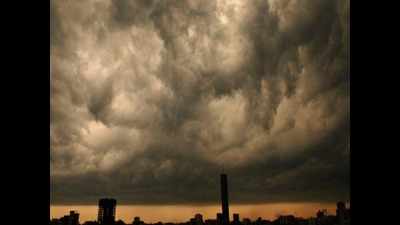- News
- City News
- kolkata News
- IIT-Kharagpur study to decode climate change-squall link
Trending
This story is from May 20, 2018
IIT-Kharagpur study to decode climate change-squall link
Following a sharp increase in the number of thunderstorms, squalls and nor'westers since March, scholars at IIT-Kharagpur are now studying them to know if there has been a major climate in Bengal in the last 100 years.

Weathermen said that 29 thunderstorms, squalls and nor’westers have hit Bengal since March.
KOLKATA: Following a sharp increase in the number of thunderstorms, squalls and nor'westers since March, scholars at IIT-Kharagpur are now studying them to know if there has been a major climate in Bengal in the last 100 years.
Scientists of the Centre for Oceans, Rivers, Atmosphere and Land Sciences (CORAL), a geo sciences school of IIT-Kharagpur, have been asked by the department of science of technology to study climate change keeping the focus on the frequent thunderstorms.According to the Indian Meteorological Department, the number of thunderstorms/squalls and nor'westers that have hit Bengal since March is 29.
"It's indeed alarming. Between 2006 and 2010, the number had dwindled and Bengal got only a handful of squalls, but the number picked up after that. This year, however, it has reached the level of a phenomenon," said ANV Satyanarayanan, head of CORAL. There are two matrices that are being studied carefully in the context of Bengal - Convective Available Potential Energy (CAPE) and Convective Inhibition Energy (CIN). "These two weather phenomenon come into play to cause nor'westers. When CAPE is high and CIN is low squalls happen. In case of Bengal, there is a situation now when CAPE is very high and CIN is very low, causing so many nor'westers so frequently. This is a clear indication of uneven heat pockets that are being created because of pollution and greenhouse gas emissions among other things," Satyanarayanan said.
Researchers have observed that while in Gangetic West Bengal formation of convective clouds is routine, of late the height of the clouds often go up to 25 kilometres, as a result of which the disturbances are widespread. They are also studying the compartments inside these clouds that have up and down drafts of breeze that quicken the disturbance.
Scientists of the Centre for Oceans, Rivers, Atmosphere and Land Sciences (CORAL), a geo sciences school of IIT-Kharagpur, have been asked by the department of science of technology to study climate change keeping the focus on the frequent thunderstorms.According to the Indian Meteorological Department, the number of thunderstorms/squalls and nor'westers that have hit Bengal since March is 29.
"It's indeed alarming. Between 2006 and 2010, the number had dwindled and Bengal got only a handful of squalls, but the number picked up after that. This year, however, it has reached the level of a phenomenon," said ANV Satyanarayanan, head of CORAL. There are two matrices that are being studied carefully in the context of Bengal - Convective Available Potential Energy (CAPE) and Convective Inhibition Energy (CIN). "These two weather phenomenon come into play to cause nor'westers. When CAPE is high and CIN is low squalls happen. In case of Bengal, there is a situation now when CAPE is very high and CIN is very low, causing so many nor'westers so frequently. This is a clear indication of uneven heat pockets that are being created because of pollution and greenhouse gas emissions among other things," Satyanarayanan said.
Researchers have observed that while in Gangetic West Bengal formation of convective clouds is routine, of late the height of the clouds often go up to 25 kilometres, as a result of which the disturbances are widespread. They are also studying the compartments inside these clouds that have up and down drafts of breeze that quicken the disturbance.
"We are using weather data from global models to plot our graphs. Once our study is over, we will also be able to indicate how number of winter days is decreasing in Bengal and that of summer days is rising," Satyanarayanan said. The team is studying data of the past 100 years so that it can present a projection till 2050. The report should be ready by the end of 2018.
End of Article
FOLLOW US ON SOCIAL MEDIA










